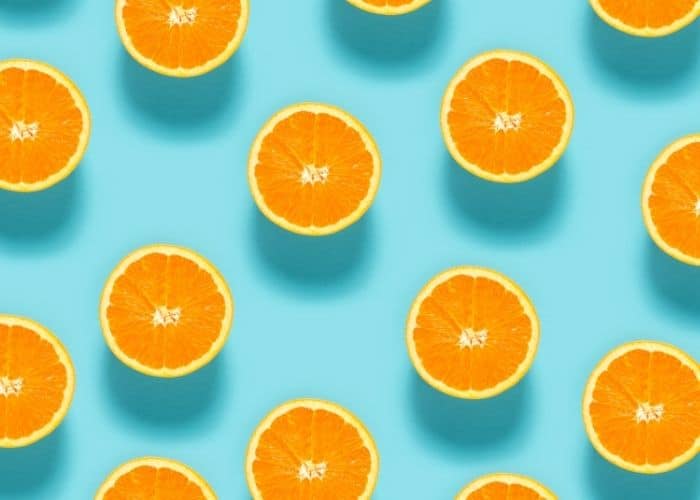
It’s no secret that processed orange juice is loaded up with artificial sugar that leaves you wanting more in the flavor department.
Not to mention, the nutritional value has been compromised to accommodate processing and storing for extended periods of time in supermarkets.
So, what can you do to get freshly squeezed orange juice?
Make it yourself.
To do that, you’re probably wondering what the best oranges for juicing are.
Have no fear…
We’ve analyzed as many orange varieties as we could to bring you a comprehensive guide that takes into account calories, acid, sweetness, bitterness, cost, and more.
The Valencia orange is the best sweet orange for juicing. Containing 85% water, it yields a lot of juice with a high Vitamin C concentration. At only 45 calories per orange, the Valencia orange is sweet, has good acid and no bitterness, and is readily available at supermarkets.
If we haven’t sold you quite yet, don’t worry. Here’s our analysis of the top 5 oranges:
Table of Contents
Top 5 Oranges for Juicing
| Valencia Orange | Satsuma Orange | Hamlin Orange | Cara Cara Orange | Blood Orange | |
|---|---|---|---|---|---|
| Juice Potential | 10 | 8 | 9 | 8 | 8 |
| Sweetness | 9 | 10 | 9 | 8 | 7 |
| Acidity | 8 | 6 | 6 | 4 | 7 |
| Bitterness | 1 | 2 | 2 | 1 | 2 |
| Flavor | 10 | 8 | 8 | 8 | 8 |
| Cost | 2 | 3 | 3 | 3 | 4 |
| Overall Juice Friendliness Score | 9.3 | 8.2 | 8.2 | 7.7 | 7.7 |
We’ll review 18 oranges/citrus fruits in total that you can juice as well as four others you shouldn’t.
Let’s get started!
Overview on the 19 Best Oranges for Juicing
When creating our comprehensive overview, we knew we had to include more varieties, hybrids, and citrus fruits than any other review post out there.
This list likely includes orange varieties you’ve never heard of.
Don’t despair…
We break them down and include helpful stats for each kind of orange so you can make the best judgment on whether you should juice it or not.
We broke the oranges into three categories:
- Oranges you should never juice
- Non-orange citrus fruits that deserve your attention
- Oranges that are delicious and nutritious for you to juice at home
Here’s the full list of oranges in reverse order:
- Seville Orange
- Bergamot Orange
- Trifoliate Orange
- Byeonggul Orange
- Orangelo
- Pomelo
- Grapefruit
- Tangelo
- Jaffa Orange
- Navel Orange
- Lima Orange
- Parson Brown Orange
- Pineapple Orange
- Sweet Orange
- Tangerine
- Clementine
- Mandarin
- Blood Orange
- Cara Cara Orange
- Hamlin Orange
- Satsuma Orange
- Valencia Orange
If you’d rather skip to read about a certain orange variety, click here to see the table of contents.

Benefits of Fresh-Squeezed Orange Juice
There are a few main benefits off the bat to juice your own oranges at home:
- You control the quality (and lack of preservatives)
- You get the full impact of the nutrients present in raw fruits
- You can save money if you juice high-yield oranges
A study published in the Journal of Lipid Research concluded that citrus flavonoids help to reverse obesity and regulate metabolic dysfunction.
In other words, orange juice can help you lose weight.
On this site, we endorse any healthy way to do just that.
How We Evaluated All These Oranges
Amalgamating data from 20+ citrus varieties took many hours, but we’re proud to present it.
We evaluated the oranges based on the following criteria:
- Juice Potential
- Sweetness
- Acidity
- Bitterness
- Flavor
- Cost
We then took the scores (1-10) and averaged them out for an overall juice friendliness score.
It’s worth noting that the bitterness and cost scores are reversely coded.
Translation: since bitterness is undesirable in an orange, a low score for bitterness results in a higher average. The same goes for cost.
We also researched the scientific name for each orange as well as how many calories each had (for as many as we could find).
You’ll find all this information in easy-to-read tables.
4 Oranges You Should Never Juice (But Are Still Good for You)
The three oranges you should never juice are:
- Seville Orange
- Bergamot Orange
- Trifoliate Orange
- Byeonggul Orange
Even though you can’t juice them, we decided to include them because they do have health benefits for you when processed differently.
22. Seville Orange
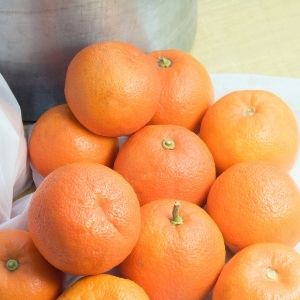
Also known as the bitter or sour orange, the Seville orange is grown in secluded and wooded parts of Florida and the Bahamas after being introduced by Spaniards.
Bitter oranges are widely used for essential oils and are used for perfume.
Here’s what you need to know about Seville oranges:
Seville Orange
| Citrus Aurantium Calories: N/A |
|
|---|---|
| Juice Potential | 1 |
| Sweetness | 1 |
| Acidity | 9 |
| Bitterness | 10 |
| Flavor | 1 |
| Cost | 8 |
| Overall Juice Friendliness Score | 2.7 |
The raw pulp from this orange is NOT edible, so it is not suited for juicing.
However, because of the high percentage of pectin, they are widely used for marmalade production.
21. Bergamot Orange
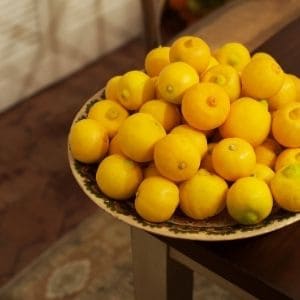
Commercially grown in Calabria, Italy, the bergamot orange is an orange, but it looks like a lime or lemon from the exterior.
Extracts from this orange are used widely in oils, perfumes, and cosmetics.
Here’s what you need to know about bergamot oranges:
Bergamot Orange
| Citrus Bergamia Calories: N/A |
|
|---|---|
| Juice Potential | 1 |
| Sweetness | 1 |
| Acidity | 9 |
| Bitterness | 8 |
| Flavor | 1 |
| Cost | 7 |
| Overall Juice Friendliness Score | 3.2 |
If you’ve drunk Earl Grey tea before, then you’ll know bergamot from the citrusy flavor the tea has.
The bergamot orange is classified as a subspecies of bitter orange, so it isn’t ideal for juicing.
20. Trifoliate Orange
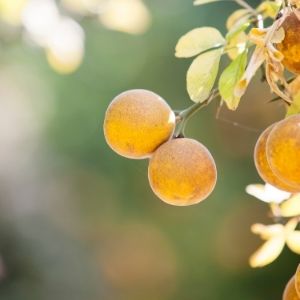
The trifoliate orange is also known as the:
- Japanese bitter orange
- Chinese bitter orange
- Hardy orange
It’s notorious for having compound leaves and a fuzzy rind, almost like a peach. Similar in size to a lime but resembling an orange, these oranges are green and ripen to yellow.
Trifoliate oranges often have a high concentration of seeds.
In Central London, these oranges can be seen in the gardens of St. Paul’s Cathedral.
Here’s what you need to know about trifoliate oranges:
Trifoliate Orange
| Citrus Trifoliata Calories: N/A |
|
|---|---|
| Juice Potential | 3 |
| Sweetness | 2 |
| Acidity | 8 |
| Bitterness | 9 |
| Flavor | 3 |
| Cost | 9 |
| Overall Juice Friendliness Score | 3.3 |
Trifoliate oranges are widely used as rootstock for other orange varieties, but you don’t want to eat this one. These oranges are quite bitter due to their poricin content (an acidic protein).
You can marmalade out of these oranges, but most consider them inedible raw, so juicing is not a wise choice.
But, trifoliate oranges are widely used in Eastern Asian medicine to reduce allergic inflammation.
19. Byeonggul Orange
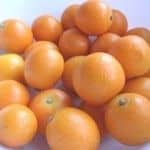
Byeonggul oranges originate from Korea and more specifically, Jeju Island.
The oldest byeonggul tree is thought to be roughly 250 years old, dating back to the Joseon dynasty. Genetic testing has suggested that byeonggul, sweet oranges, and key limes share a common ancestor.
The yellow-orange fruit with a dimpled rind is known for being resistant to cold temperatures, blight, and insect attacks.
Here’s what you need to know about byeonggul oranges:
Byeonggul Orange
| Citrus Platymamma Calories: N/A |
|
|---|---|
| Juice Potential | 3 |
| Sweetness | 6 |
| Acidity | 6 |
| Bitterness | 2 |
| Flavor | 7 |
| Cost | 10 |
| Overall Juice Friendliness Score | 5.3 |
While the flesh can be eaten raw, byeonggul oranges are more traditionally used for their natural and holistic medicinal usages.
The dried peel is commonly used to make tea, which is a home remedy for treating respiratory ailments, loss of appetite, and digestive problems.
Because they’re widely unavailable outside of Korea, byeonggul oranges are not your best choice for juicing, especially when the best health part is in the rind.
4 Non-Orange Citrus Fruits Great for Juicing That Deserve Your Attention
You might not want to drink lemon or lime juice straight, but that doesn’t mean you can’t give some other citrus fruits the love they deserve.
These citrus fruits are in some way related to oranges, whether that’s contributing to an orange species or being a hybrid.
The four in this section are:
- Orangelo
- Pomelo
- Grapefruit
- Tangelo
We hope you give these citrus fruits a chance when you run out of oranges to juice.
18. Orangelo
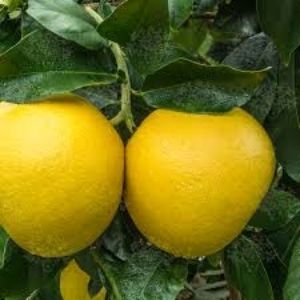
The orangelo is a hybrid citrus fruit believed to have originated in Puerto Rico.
A cross between a grapefruit and an orange, it spontaneously appeared on the shade-providing trees on the coffee plantations there.
Noticing that there were citrus fruits growing on the trees that were larger and a brighter yellow from the ones they were used to seeing, Carlos G. Morosco, from the University of Puerto Rico, marked the discovery in 1956.
Here’s what you need to know about orangelos:
Orangelo
| Citrus Sinensis x Citrus Paradisi Calories: 63/ea |
|
|---|---|
| Juice Potential | 8 |
| Sweetness | 8 |
| Acidity | 7 |
| Bitterness | 1 |
| Flavor | 8 |
| Cost | 7 |
| Overall Juice Friendliness Score | 7.5 |
Orangelos are eaten similarly to grapefruit, but are sweeter and brighter in color.
Round to pear-shaped, they are also easier to peel. They don’t have any bitterness and are mild on the palate.
Great for juicing, orangelos are:
- 82% Water
- 16% Carbohydrates
17. Pomelo
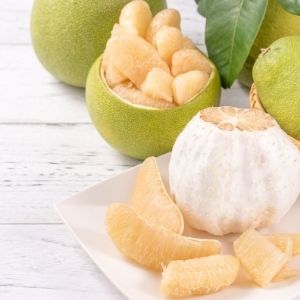
The pomelo is the largest citrus fruit from the family Rutaceae weighing 2-4 pounds on average.
That’s a whole lotta citrus.
A non-hybrid, it’s native to Southeast Asia and is similar in taste to a sweet grapefruit despite its green exterior.
It has little bitterness as compared to grapefruit.
The sweet kind with white flesh is best for juicing as the pink sour variant is more likely to be used in ceremonies than for consumption.
Here’s what you need to know about pomelos:
Pomelo
| Citrus Maxima Calories: 86/8oz |
|
|---|---|
| Juice Potential | 9 |
| Sweetness | 9 |
| Acidity | 5 |
| Bitterness | 2 |
| Flavor | 8 |
| Cost | 5 |
| Overall Juice Friendliness Score | 7.7 |
When you’re done juicing it, you can take the rind and make preserves or candy it.
Ideal for juicing, pomelos contain:
- 89% Water
- 10% Carbohydrates
- 73% Vitamin C (of the daily value)
16. Grapefruit
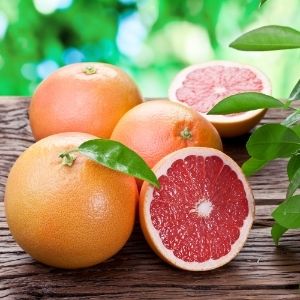
Grapefruit is a subtropical citrus fruit with a taste known for being sour to semisweet and somewhat bitter.
Scientists first documented it in 1750 as a “forbidden fruit,” confusing it with the pomelo. It’s now known to be an accidental cross between the pomelo and the sweet orange.
Grapefruit varieties differ based on their flesh, which can range from pink to yellow to ruby red.
Genetic mutation is widely used to achieve the different varieties, which accordingly vary with their respective composition of sugars (mainly sucrose) and acid (mainly citric acid).
Here’s what you need to know about grapefruits:
Grapefruit
| Citrus Paradisi Calories: 82/ea |
|
|---|---|
| Juice Potential | 9 |
| Sweetness | 6 |
| Acidity | 9 |
| Bitterness | 4 |
| Flavor | 8 |
| Cost | 2 |
| Overall Juice Friendliness Score | 8.0 |
Excellent for juicing, raw grapefruit contains:
- 90% Water
- 8% Carbohydrates
- 40% Vitamin C (of the daily value)
Grapefruits have half the acid of lemons and limes and twice the acid of traditional orange juice. If you don’t like your juice to be too sweet, consider using grapefruit.
Weight-Friendly Tip
Check with your doctor to see if grapefruit counteracts or worsens the effects of any medication you take, specifically if you’re a diabetic.15. Tangelo

The tangelo, sometimes referred to as the honeybell, is a hybrid fruit of a citrus reticulata variety (such as tangerine or mandarin) and a citrus maxima variety (such as pomelo or grapefruit).
The size of an adult fist, tangelos have a characteristic “nipple” where the stem is.
With a tart and tangy taste, this fruit bursts with juice, almost at the expense of having flesh to eat.
There are many varieties of tangelos, but the most popular ones originated in Florida between the 1910s and 1930s.
Here’s what you need to know about tangelos:
Tangelo
| Citrus Tangelo Calories: 45/ea |
|
|---|---|
| Juice Potential | 10 |
| Sweetness | 8 |
| Acidity | 9 |
| Bitterness | 1 |
| Flavor | 9 |
| Cost | 5 |
| Overall Juice Friendliness Score | 8.7 |
Great for juicing, tangelos are noted for their rich juiciness, mild and sweet flavor, distinct zesty smell, and large size.
But, they are seasonal, only available from mid-November to the beginning of February.
14 Delicious and Nutritious Oranges for Juicing at Home
Now on to the main event.
Many review articles don’t even mention some of the oranges on this list, which is a crime because they’re used in commercial juice production.
A couple of things to be aware of as you read through the various oranges:
- How many seeds each orange has (we’ll mention below if it’s relevant)
- The size of the orange (larger fruit generally means more juice)
- Seasonality (not all oranges are available at all times)
- The majority of oranges in this section fall under “citrus sinensis,” which is a sweet orange, so watch how much sugar you consume, especially if you’re a diabetic
- How many calories each orange has (weight loss at its core is about a caloric deficit, so it doesn’t hurt to keep track)
We used the MyFitnessPal tool to find calories on as many of the oranges as possible and then supplemented with other sites.
This section includes orange varieties in their own right, but also some that are subspecies or varieties within a variety.
We wanted to provide you with a large variety so when you walk into the supermarket or specialty foods store, you can hopefully find a familiarly named orange to juice.
The best kinds of oranges for juicing in this section are:
- Jaffa Orange
- Navel
- Lima Orange
- Parson Brown Orange
- Pineapple Orange
- Sweet Orange
- Tangerine
- Clementine
- Mandarin
- Blood Orange
- Cara Cara Orange
- Hamlin Orange
- Satsuma Orange
- Valencia Orange
If you can’t make up your mind about which orange to juice, you can trust us.
We concluded earlier that the Valencia orange is the best for juicing.
14. Jaffa Orange
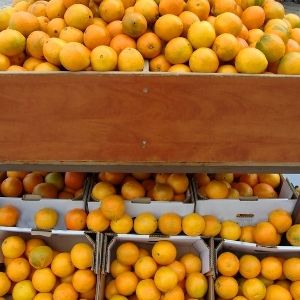
The Jaffa orange, also known as the Shamouti orange, is an orange variety known for export because of its few seeds and tough rind.
Developed by Palestinian farmers in the 19th century, this orange gets its name from its origin city: Jaffa, Israel. Jaffa oranges used to be the most popular Israeli export, but they’ve declined in recent history.
These oranges are distinguished by their oval shape and thick peel, which has a deep orange color and is easy to remove.
Here’s what you need to know about Jaffa oranges:
Jaffa Orange
| Citrus Sinensis 'Jaffa' Calories: 57/ea |
|
|---|---|
| Juice Potential | 6 |
| Sweetness | 7 |
| Acidity | 5 |
| Bitterness | 5 |
| Flavor | 9 |
| Cost | 5 |
| Overall Juice Friendliness Score | 8.7 |
Even though they store well, Jaffa oranges aren’t used for commercial juicing.
Jaffa oranges produces less juice than other varieties and has a tendency for delayed bitterness on the palate, but they do have some sweetness.
Feel free to experiment juicing these oranges at home. Everyone perceives bitterness differently.
13. Navel Orange
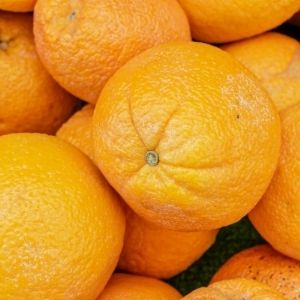
Navel oranges, named for the protruding second fruit growth on their end, slightly resemble a human navel.
These oranges are primarily grown for human consumption because they have less juice and a thicker skin, which is ideal for peeling.
Scientists speculate that the first navel oranges came from a tree Bahia, Brazil on the grounds of a monastery between 1810 and 1820.
Unlike many other orange varieties, these are only propagated through cutting and grafting, which is a fancy way of saying that today’s navel oranges are nearly identical to the ones discovered in the 19th century and haven’t been genetically tampered with.
Here’s what you need to know about navel oranges:
Navel Orange
| Citrus Sinensis 'Navel' Calories: 70/ea |
|
|---|---|
| Juice Potential | 7 |
| Sweetness | 8 |
| Acidity | 7 |
| Bitterness | 9 |
| Flavor | 7 |
| Cost | 2 |
| Overall Juice Friendliness Score | 6.7 |
Navel oranges are great for juicing, but you have to consume the juice quickly.
They have a high concentration of limonin and other limonoids, which are the compounds responsible for bitterness.
They’re activated by oxygen, so a navel orange’s juice will begin to taste bitter within 30 to 60 minutes of exposure.
Navel oranges contain:
- 78% Water
- 17.5% Carbohydrates
- 3.1g Fiber (per serving)
This isn’t the orange to juice in advance for the next day, even if you store it in an airtight container.
12. Lima Orange
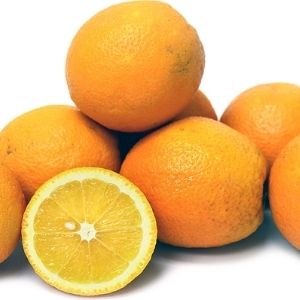
Widely grown in Brazil, Lima oranges are small to medium in size and are round to semi-lopsided in shape. With a leathery, medium-thick pocked rind, these oranges are laden with fragrant oils.
You can get about 8-10 segments from a Lima orange.
Soft, tender, and juicy, these oranges also come with a few cream-colored seeds underneath a tightly clinging white pith.
Here’s what you need to know about Lima oranges:
Lima Orange
| Citrus Sinensis 'Lima' Calories: 70/ea |
|
|---|---|
| Juice Potential | 8 |
| Sweetness | 9 |
| Acidity | 2 |
| Bitterness | 2 |
| Flavor | 7 |
| Cost | 6 |
| Overall Juice Friendliness Score | 6.7 |
Lima oranges are available in the late winter to spring.
Lima oranges are a great source of:
- Vitamin C
- Vitamin A
- Potassium
- Folate
- Fiber
Good for juicing, these oranges are best consumed raw and quickly.
Acidless oranges like this aren’t used in commercial juice because they don’t hold well long-term.
And orange juice without acid isn’t balanced, so you may have to experiment with using the Lima orange in a blend with another orange or citrus fruit.
11. Parson Brown Orange
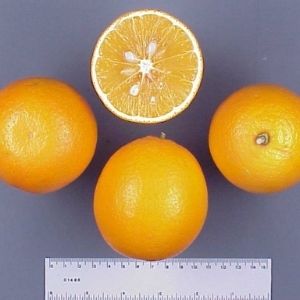
The Parson Brown orange has been widely regarded as a leading juicing orange in Florida for many years.
This variety is a type of sweet orange that’s purported to have first been planted in 1856, although the propagation rights were purchased in 1875 by J. L. Carney who named the fruit.
The orange has never really achieved commercial prominence outside of Florida because of its seediness. For reference, each orange has about 10 to 30 seeds.
Orange varieties with more juice, a better yield, higher acid, and higher sugar content have been developed, leaving this variety at the wayside.
Here’s what you need to know about Parson Brown oranges:
Parson Brown Orange
| Citrus Sinensis 'Parson Brown' Calories: 70/ea |
|
|---|---|
| Juice Potential | 7 |
| Sweetness | 8 |
| Acidity | 6 |
| Bitterness | 5 |
| Flavor | 7 |
| Cost | 4 |
| Overall Juice Friendliness Score | 6.8 |
The Parson Brown orange matures the earliest, though, which is why it is still grown.
Here are the maturation specifics:
- Texas: September
- Florida: From October to early January
Although the fruit has a poor rind and juice color, it’s still great for juice if you don’t mind picking out the seeds first.
10. Pineapple Orange
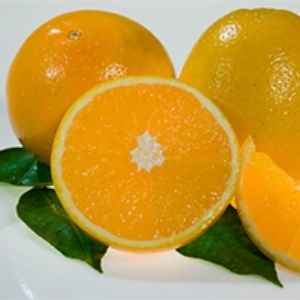
The pineapple orange is an excellent juice and eating orange.
Medium to large in size, they are round to oval in shape and yellow to red-orange in color. Much like other citrus fruits, the peel is pebbly.
Contrary to the name, these oranges do not actually taste like pineapple.
Pineapple oranges are the oldest variety grown in Florida, but they are quickly being replaced by newer seedless varieties.
Here’s what you need to know about pineapple oranges:
Pineapple Orange
| Citrus Sinensis 'Pineapple' Calories: 70/ea |
|
|---|---|
| Juice Potential | 8 |
| Sweetness | 9 |
| Acidity | 4 |
| Bitterness | 5 |
| Flavor | 8 |
| Cost | 4 |
| Overall Juice Friendliness Score | 7.0 |
The pineapple orange grows from November to early January.
These oranges are commonly ranked sweeter than navel oranges and some people think they have a slightly spicy smell.
If you don’t mind removing the roughly 15-25 seeds in advance, these oranges are great for juicing.
9. Sweet Orange
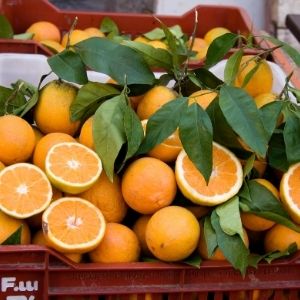
Sweet oranges are by name, sweet.
Their domestic origin is a cross between a non-pure mandarin orange and a hybrid pomelo.
The earliest mention of the sweet orange dates back to 334 B.C. in Chinese literature. By 1646, the sweet orange was well-known in Europe, with King Louis XIV of France having built the grandest orangerie at the Royal Palace of Versailles.
Here’s what you need to know about sweet oranges:
Sweet Orange
| Citrus Sinensis Calories: 70/ea |
|
|---|---|
| Juice Potential | 8 |
| Sweetness | 10 |
| Acidity | 1 |
| Bitterness | 1 |
| Flavor | 6 |
| Cost | 3 |
| Overall Juice Friendliness Score | 7.2 |
Sweet oranges can be used to help treat:
- High cholesterol
- High blood pressure
- Stroke prevention
High in Vitamin C, some researchers believe sweet oranges can help treat asthma.
Sweet oranges also contain fragrant oils in the rind, which is extracted to form sweet orange oil.
Overall, sweet oranges are great for juicing, but they have less acid than other oranges.
Weight-Friendly Tip
If you’re diabetic, pre-diabetic, or someone who needs to watch their sugar, stay far away from juicing the sweet orange. Too much of this highly concentrated fructose will skyrocket your sugar numbers. Instead, try juicing an orange variety with less sugar and more acid.8. Tangerine
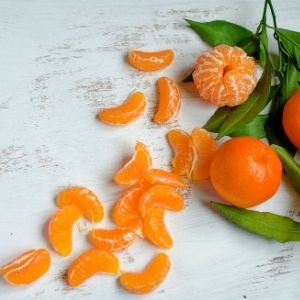
The tangerine is an orange-colored citrus fruit consisting of hybrids of the mandarin orange and the pomelo.
With its origin in Morocco, the fruit was named for the Tangier region it came from.
Tangerines are smaller and less rounded than common oranges, with a pebbly skin devoid of deep grooves.
Regarding taste, tangerines are less sour and sweeter than regular oranges.
Here’s what you need to know about tangerines:
Tangerine
| Citrus Tangerina Calories: 47/ea |
|
|---|---|
| Juice Potential | 6 |
| Sweetness | 8 |
| Acidity | 6 |
| Bitterness | 2 |
| Flavor | 8 |
| Cost | 3 |
| Overall Juice Friendliness Score | 7.5 |
Tangerines have a peak season between autumn and spring. You can also find tangerines turned into an essential oil, which nourishes your skin.
Great for juicing, this fruit contains:
- 85% Water
- 13% Carbohydrates
- 32% Vitamin C (of the daily value)
Don’t confuse tangerines with tagines. They’re the Moroccan cooking vessel.
7. Clementine
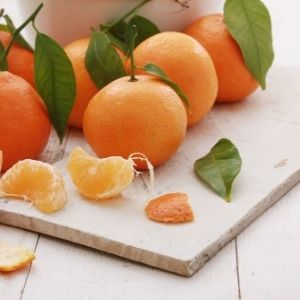
Clementines are a cross between mandarin oranges and sweet oranges, named for its 19th century discoverer.
They have a deep orange color with a glossy exterior and are easy to peel and segment.
Juicy and sweet with less acid than oranges, clementines are available seeded and seedless.
Here’s what you need to know about clementines:
Clementine
| Citrus Clementina Calories: 35/ea |
|
|---|---|
| Juice Potential | 7 |
| Sweetness | 8 |
| Acidity | 6 |
| Bitterness | 2 |
| Flavor | 8 |
| Cost | 3 |
| Overall Juice Friendliness Score | 7.7 |
A clementine contains:
- 87% Water
- 12% Carbohydrates
- 59% Vitamin C (of the daily value)
When you think about juicing this orange, consider the cost and how many you need to get a full glass of orange juice.
6. Mandarin
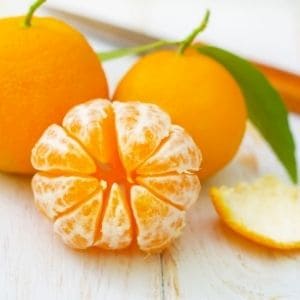
Mandarins are a small citrus fruit treated as a distinct species of oranges.
Smaller and resembling a flattened sphere, they are sweeter than traditional oranges with less sourness.
When ripe, mandarins are firm to slightly soft and have pebbly skin, but are quite easy to peel and segment.
Mandarins are either seedless or contain a small number of seeds, which makes them easy to eat raw (and whole) or juice.
Here’s what you need to know about mandarin oranges:
Mandarin
| Citrus Reticulata Calories: 47/ea |
|
|---|---|
| Juice Potential | 8 |
| Sweetness | 8 |
| Acidity | 6 |
| Bitterness | 4 |
| Flavor | 8 |
| Cost | 2 |
| Overall Juice Friendliness Score | 7.7 |
In traditional Chinese medicine, dried mandarin peel helps to regulate chi and aid in digestion, but you can also find the rind turned into an essential oil.
Great for juicing, mandarins contain:
- 85% Water
- 13% Carbohydrates
- 32% Vitamin C (of the daily value)
5. Blood Orange
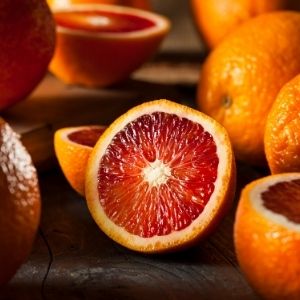
Blood oranges are a variety of orange with crimson, almost blood-like flesh.
The color is attributed to the presence of anthocyanins.
Anthocyanins are also present in:
- Blueberries
- Blackberries
- Other dark fruits
However, anthocyanins are quite uncommon in citrus fruits, which gives the blood orange bonus points.
Weight-Friendly Tip
You may have heard the expression “eat the rainbow” before and not just in a Skittles commercial. The idea is that eating differently colored foods gives you the various vitamins and minerals your body needs to be healthy.In addition to the usual citrus notes, these oranges may reminisce raspberries in flavor.
The blood orange is a natural mutation of the orange.
Commonly grown in Italy (and with a protected geographic status), these oranges are thought to originate in the Mediterranean.
The distinctive color only develops when the temperature is low at night.
Here’s what you need to know about blood oranges:
Blood Orange
| Citrus Sinensis 'Blood Orange' Calories: 70/ea |
|
|---|---|
| Juice Potential | 8 |
| Sweetness | 7 |
| Acidity | 7 |
| Bitterness | 2 |
| Flavor | 8 |
| Cost | 4 |
| Overall Juice Friendliness Score | 7.7 |
In the United States, blood oranges are in season in:
- Texas: From December to March
- California: From November to May
Blood orange juice ranges from being somewhat tart to kind of sweet, providing a great balance for juicing.
They contain more than 20% of the daily value for Vitamin C and dietary fiber and are a moderate source of folate.
4. Cara Cara Orange
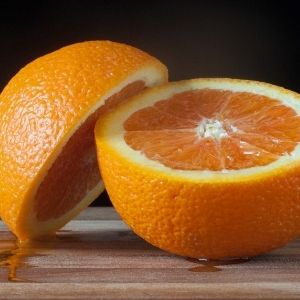
Cara Cara oranges, a type of navel oranges, are also known as red-fleshed navel oranges.
They are believed to be a spontaneous bud mutation on a Washington navel tree. Dating back to their 1977 discovery in Hacienda Caracara in Valencia, Venezuela, these oranges did not enter the U.S. consumer market until the late 1980s.
This medium-sized orange is seedless, sweet, and low in acid.
Cara Cara oranges are more nuanced in flavor than most others, evoking notes of cherry, rose petal, and blackberry.
Here’s what you need to know about Cara Cara oranges:
Cara Cara Orange
| Citrus Sinensis 'Cara Cara' Calories: 80/ea |
|
|---|---|
| Juice Potential | 8 |
| Sweetness | 8 |
| Acidity | 4 |
| Bitterness | 1 |
| Flavor | 8 |
| Cost | 3 |
| Overall Juice Friendliness Score | 7.7 |
Unlike blood oranges who have their color because of anthocyanins, these oranges’ pigmentation is due to carotenoids such as lycopene.
Cara Cara oranges enter the market in:
- South America: August
- Venezuela: October
- California: Late November (and available through April)
These oranges are great for juicing, with one orange containing high amounts of Vitamin C and A.
3. Hamlin Orange
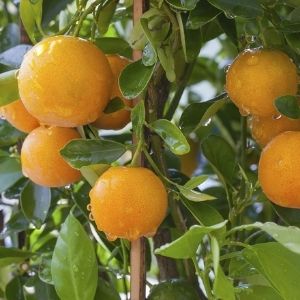
Sweet and juicy, Hamlin oranges have few to no seeds, making them great for juicing.
These oranges are named for the guy who cultivated them, A. G. Hamlin near Glenwood, Florida in 1879. This variety is frequently grafted on lemon rootstock, so the juice may be paler in color.
Fruit from Hamlin orange trees are harvested between October and December.
This orange is one of the most popular juicing varieties in Florida and has replaced the Parson Brown variety as the principal early-season orange.
Here’s what you need to know about Hamlin oranges:
Hamlin Orange
| Citrus Sinensis 'Hamlin' Calories: 60/ea |
|
|---|---|
| Juice Potential | 9 |
| Sweetness | 9 |
| Acidity | 6 |
| Bitterness | 2 |
| Flavor | 8 |
| Cost | 3 |
| Overall Juice Friendliness Score | 8.2 |
These oranges have a thin rind with a lot of seedless flesh, so juicing them is ideal. They may be a little too juicy for eating, though.
Hamlin oranges contain:
- 81% Water
- 17% Carbohydrates
If you find them in your local supermarket, they’re a great pick.
2. Satsuma Orange
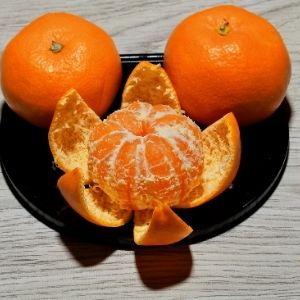
The Satsuma orange is a semi-seedless and easy-peeling orange species of Chinese origin named after Unsyu (Wenzhou), China.
It was introduced to the West via Japan and is known for being a highly inbred mandarin-pomelo hybrid.
The size of Mandarin oranges, it is one of the sweetest citrus varieties.
Their flesh is incredibly delicate and cannot withstand careless handling.
Here’s what you need to know about Satsuma oranges:
Satsuma Orange
| Citrus Unshiu Calories: 46/ea |
|
|---|---|
| Juice Potential | 8 |
| Sweetness | 10 |
| Acidity | 6 |
| Bitterness | 2 |
| Flavor | 8 |
| Cost | 3 |
| Overall Juice Friendliness Score | 8.2 |
Satsuma oranges have high concentrations of Vitamin C and synephrine, which is a natural decongestant to help relieve cold and allergy symptoms.
Satsuma oranges contain:
- 87% Water
- 12% Carbohydrates
You can also find Satsuma oranges in many cosmetic products.
1. Valencia Orange
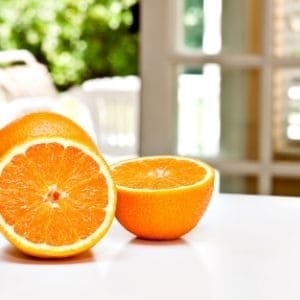
The Valencia orange is a sweet orange first hybridized by pioneer land developer and agronomist William Wolfskill in the mid-19th century in Santa Ana, California.
He named it after Valencia, Spain, which was known for its sweet orange trees.
In the mid-20th century, Florida botanist Lena B. Smithers Hughes made major improvements to the orange, resulting in the Hughes Valencia bud line comprising 60% of all Valencia oranges cultivated in Florida in 1983.
Here’s what you need to know about Valencia oranges:
Valencia Orange
| Citrus Sinensis 'Valencia' Calories: 45/ea |
|
|---|---|
| Juice Potential | 10 |
| Sweetness | 9 |
| Acidity | 8 |
| Bitterness | 1 |
| Flavor | 10 |
| Cost | 2 |
| Overall Juice Friendliness Score | 9.3 |
Even though they have on average 0-9 seeds per fruit, their excellent taste and internal color are prime for juicing.
Valencia oranges are primarily grown for processing and juice production.
Their commercial harvest season runs from March to June in Florida.
The best for juicing, Valencia oranges contain:
- 85% Water
- 14% Carbohydrates
They’re also a good source of Vitamin C and flavonoids.
Common applications include Valencia orange peel as a seasoning and Valencia orange as a liquid sugar-alternative sweetener.
FAQs on Juicing Oranges
You probably have questions regarding juicing oranges at home.
I’d be surprised if you didn’t.
Here are a few we thought of in advance:
- What equipment should I use to juice an orange?
- Which oranges are easy to peel?
- Should I peel oranges before juicing?
- Can I put whole oranges in a juicer?
- How many oranges make a cup of juice?
- Is it cheaper to make your own orange juice?
Let us know in the comments below if you have additional questions we can answer.
1. What Equipment Should I Use to Juice an Orange?
There are two kinds of equipment you can use to juice oranges:
- Manual juicer
- Centrifugal/Masticating juicer
Manual juicers are exactly what they sound like. You place an orange inside the apparatus and press down to release the juice.
Manual juicers don’t require that much energy and are typically less expensive than centrifugal and masticating juicers.
The more sophisticated equipment lies with the centrifugal and masticating juicers.
Centrifugal juicers use spinning blades to break up flesh and separate it from its juice, which is then passed through a fine mesh strainer.
Be careful, though…
Centrifugal juicers use heat, so nutrients will denature (lose their power) the longer you keep the fruit in the juicer for.
Masticating juicers, also known as cold-press juicers, use an auger (a helix-like shaft just like you’d find on a corkscrew) that turns inside a chamber. The flesh spits out on one end and the juice gets finely strained before dropping inside a catch mechanism.
They can be a pain to assemble and disassemble, but they tend to yield more juice than centrifugal juicers.
Masticating juicers are usually more expensive for a good reason: they preserve the nutrients more, which is the whole point of juicing.
Whether you use a manual, centrifugal, or masticating juicer, the important part is that you’ll get fresh-tasting orange juice afterward.
2. Which Oranges Are Easy to Peel?
Above, we mentioned when oranges are easy to peel.
Typically, those oranges will have a slightly thicker peel that gets detached from the pith and flesh easier.
Some of those oranges include:
- Orangelo
- Jaffa Orange
- Clementine
- Mandarin
- Valencia Orange
If you’re having difficulties peeling oranges, you can use a knife to shave the rind off and you’ll be left with the flesh.
Alternatively, you could just buy a new peeler if yours got dull.
3. Should I Peel Oranges Before Juicing?
You should peel oranges if you want your orange juice to taste less bitter.
The rind and the pith are the most bitter parts of the orange, just like the seeds are the spiciest part of a hot pepper.
Unfortunately, there are some nutrients you’ll miss out on by peeling the orange, but you can always repurpose your orange peels for cooking or baking.
By peeling the oranges, you’re also making sure that any surface-level pesticides or chemical fertilizers don’t end up in your juice.
But, masticating and centrifugal juicers are equipped to juice the orange rind if you’d like to juice them anyway.
4. Can I Put Whole Oranges in a Juicer?
Yes, you can put whole oranges in a juicer.
You just might not like the final taste. Your juice will likely taste more bitter, as I just mentioned above.
Additionally, the chute to which you feed a juicer is not large enough to handle stuffing a whole orange in, so you will at least need to slice the orange in wedges first.
5. How Many Oranges Make a Cup of Juice?
The standard orange will yield between 1/4 and 1/3 cup of juice, or roughly 2 oz to 3.7 oz.
For a standard 8 oz cup of orange juice, you will need 3-4 oranges.
Of course, if you use some of the larger varieties we mentioned above, that number will decrease.
Those include:
- Pomelo
- Grapefruit
- Orangelo
If you use a smaller orange like a mandarin or clementine, then you will need more to get an 8 oz cup of juice.
6. Is It Cheaper to Make Your Own Orange Juice?
The oranges commercial orange juice producers use are often the ones blemished in some way that are worth less and can’t be sold to supermarkets.
In that regard, the cost can’t be beat for commercial juice.
But, processing orange juice to be sold includes crazy things like:
- Removing oxygen to keep the juice fresh
- Adding preservatives
- Reconstituting and adding “flavor packs”
- Fortifying with vitamins and minerals that have been removed as a result of all that
Fresh-squeezed orange juice is certainly healthier for you. Without a doubt.
But, if you’re looking for a cost comparison, then here’s one.
Commercial vs. Homemade Orange Juice Per 8 oz Cup
| Commercial Orange Juice | Homemade Orange Juice | |
|---|---|---|
| Price | $3.99 | $4.24 |
| Size | 52 oz bottle | 4 pound bag |
| Unit Cost | $0.08 / oz | $0.21 / ea |
| Cost / 8 oz | $0.64 | $0.63 to $0.84 |
You can read the mathematical breakdown below, or take our word for it.
An 8 oz cup of orange juice costs:
- Commercial: $0.64
- Homemade: $0.63 (to $0.84)
Simply Orange Juice comes in a 52 oz bottle and retails for about $3.99 when we wrote the article. You might find it cheaper or more expensive elsewhere.
That puts the cost for an ounce of commercial orange juice at $0.076, or $0.08 when you round. This means that an 8 oz cup of commercial orange juice costs roughly $0.64.
You can buy a 4 lb bag of Valencia oranges (according to Walmart) for $4.24, which puts the price per pound at $1.06.
An average Valencia orange weighs 3.4 oz and there are 16 ounces in a pound (in case you didn’t know that).
Weight-Friendly Tip
Having trouble with recipe/ingredient conversions? An easy way to remember it is that “a pint is a pound that makes the world go round.” That’s what they teach chefs in culinary school. Two cups is one pint and one pint is one pound.There are approximately 4.7 Valencia oranges in pound. For math’s sake, we’ll round that up to 5. That means each orange costs $0.212, or $0.21 when we round.
If we use three Valencia oranges to make a cup of homemade orange juice, then the cost for an 8 oz cup is $0.63.
It may actually run you a little higher if it takes you 4 oranges, which would be $0.84.
If you have a farmer’s market near you and can get oranges for cheaper or get the misfit ones commercial producers use, the cost for homemade orange juice will go lower.
All this math means that roughly speaking, an 8 oz cup of homemade orange juice is $0.01 cheaper than a cup of commercial orange juice (if you use three oranges). If you use four oranges, then an 8 oz cup of commercial orange juice is $0.21 cheaper than a cup of homemade orange juice.
If the math trips you up, then here is a table that breaks all this down for you.
Even though commercial orange juice might be a few cents cheaper depending on how many oranges you use, we believe that homemade orange juice is much better for your overall health and weight loss.
Conclusion
Sure, it’s easy to buy orange juice at the store, but why would you?
When you juice oranges at home, you get a much more intense, balanced flavor that keeps you drinking until the last drop.
There are many different kinds of oranges you can juice, but we’ll leave the top 5 here for you in case you skipped to the end:
- Blood Orange
- Cara Cara Orange
- Hamlin Orange
- Satsuma Orange
- Valencia Orange
Here’s the table for the 5 best oranges for juicing in case you want to see how they rank again:
Top 5 Oranges for Juicing
| Valencia Orange | Satsuma Orange | Hamlin Orange | Cara Cara Orange | Blood Orange | |
|---|---|---|---|---|---|
| Juice Potential | 10 | 8 | 9 | 8 | 8 |
| Sweetness | 9 | 10 | 9 | 8 | 7 |
| Acidity | 8 | 6 | 6 | 4 | 7 |
| Bitterness | 1 | 2 | 2 | 1 | 2 |
| Flavor | 10 | 8 | 8 | 8 | 8 |
| Cost | 2 | 3 | 3 | 3 | 4 |
| Overall Juice Friendliness Score | 9.3 | 8.2 | 8.2 | 7.7 | 7.7 |
Are you ready to squeeze some oranges?
Let us know how it tasted in the comments below.
To your weight-loss success!

